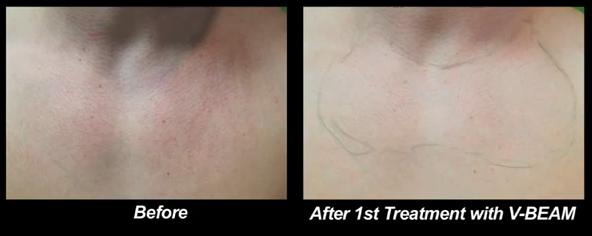Rosacea is a chronic inflammatory skin condition that occurs in adults that includes the following symptoms:
- -Facial redness & frequent blushing
- -Visible blood vessels
- -Bumps
- -Pustules
- -Rhinophyma where the nose becomes red and bulbous due to enlarged sebaceous glands that causes tissue to build up
Episodes of Rosacea flare ups occur in cycles. Symptoms will manifest for weeks at a time, sometimes lasting several months and then they disappear.
Causes of Rosacea
The exact causes of Rosacea are not completely clear. Individuals in who are seeking treatment for Rosacea should understand that their condition is likely a result of genetic predisposition and environmental factors. Rosacea tends to occur in individuals with fair skin, light colored eyes and hair. Patients can typically point out other relatives who have the condition as well as an overall family history. Predisposed individuals tend to react to environmental triggers that increase blood flow to the skin.
Examples include:
- -Hot beverages and food
- -Spicy foods
- -Alcohol
- -Extreme temperatures
- -Sun exposure
- -Stress or feelings of embarrassment
- -Exercise
- -Saunas
- -Corticosteroids
Phases of Rosacea
Rosacea is a common finding in Los Angeles where the sun is in abundance compared to other parts of the United States. Rosacea is a progressive condition which if untreated, could evolve to manifest the 3-4 phenotypic phases of the disease:
- Pre-Rosacea- general redness
- Vascular Rosacea- enlarged blood vessels
- Inflammatory Rosacea- small red bumps and pustules
- Sebaceous hyperplasia with tissue growth – typically nose (This is not inevitable however
Laser Treatment of Rosacea
There are 2 indications for treating Rosacea with lasers.
- Treatment of redness and flushing
- Treatment of sebaceous hyperplasia (tissue growth
TREATMENT OF REDNESS, DILATED BLOOD VESSELS AND FLUSHING COMPONENT OF ROSACEA
One of the most promising treatments for the redness and dilated blood vessels in Rosacea is the Vbeam laser. Every laser works by emitting light spectrum in a specific wavelengths to attain specific objectives. The Vbeam laser is a pulse dye laser which emits light waves in the 585-595nm wavelength which is readily absorbed by oxygenated hemoglobin. The red blood cells containing the hemoglobin absorp heats up as a result destroying the lining of the blood vessel containing them. The destroyed blood vessel degenerates and gets resorbed by the body over time. As a result, redness and visible blood vessels are not longer visible on the skin’s surface.
TREATMENT OF TISSUE GROWTH IN ROSACEA
The laser commonly used for this purpose is the CO2 laser which is ablative targetting water in the tissue. Recovery and healing is usually good because the reach adnexal milieu provides the bases for quicker and less complicated healing. CO2 laser treatment has largely replaced cold knife and dermabrassion treatments for sebaceous hyperplasia in rosacea.
Los Angeles Rosacea Patient Treated With the Vbeam Laser
Predisposed patients can have central chest area involvement by rosacea. This Los Angeles patient was concerned about the Rosacea on his chest which had worsened over the years. He received a treatment series of three procedures with the Vbeam laser to clear the redness in this region. Here are before and after pictures.

Los Angeles patient before and after treatment of Rosacea with the Vbeam laser*
The Vbeam laser effectively cleared the manifestation of red plaque on his chest. And the patient was very pleased with the outcome of his procedure.
Fine Touch Dermatology and Vbeam Laser Treatments for Rosacea
Medical treatment is usually adopted for the acneiform manifestations of rosacea. Most of the medications used are similarly used in the treatment of acne examples include oral and topical anitbiotics as well as retinoids. Cases of sebaceous hyperplasia have responded to oral isotretin treatment. However, topical Metronidazole which has a long tradition of use and effectiveness in the treatment of rosacea is not effective in the treatment of acne vulgaris. hence an acneiform condition that responds to topical metronidazole is more likely Rosacea rather than acne vulgaris.
Finally, if you suspect you have rosacea, be sure to consult with a board certified dermatologist. Rosacea can be mimicked by more serious conditions that include subacute cutaneous lupus erythematosus which calls for a different diagnostic and treatment algorithm.
